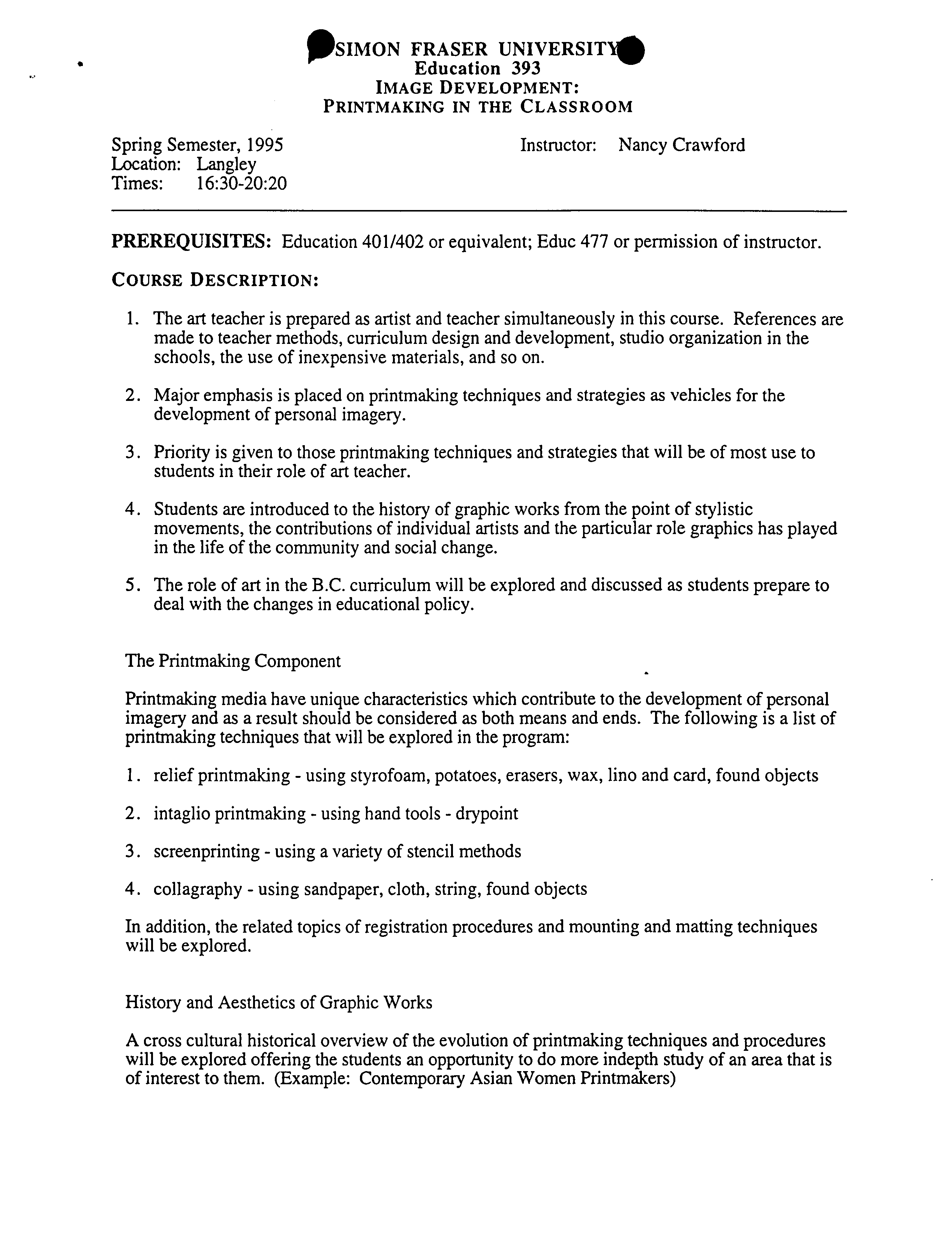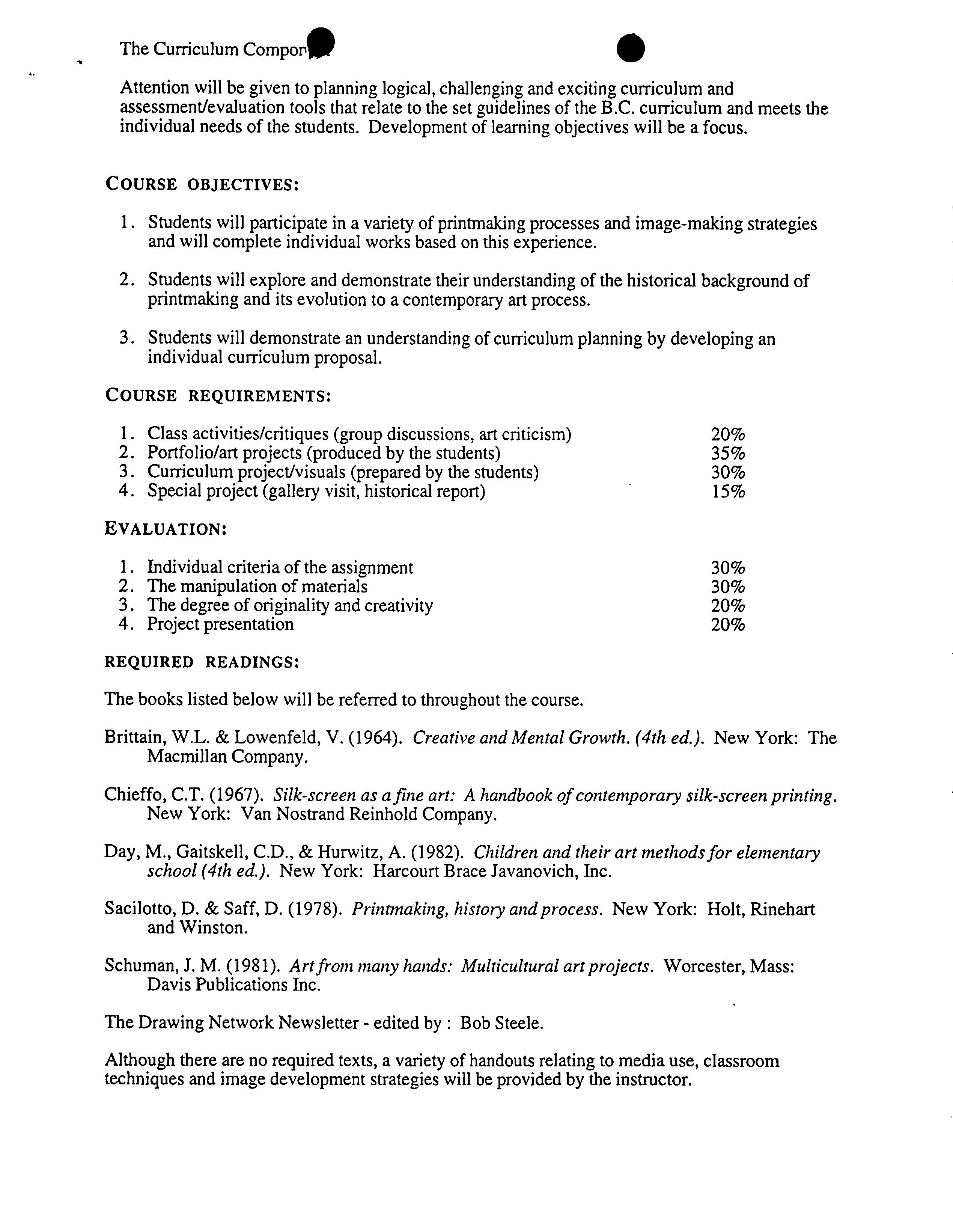PSIMON FRASER
Education
UNIVERSIT•
393 ?
?
IMAGE DEVELOPMENT: ?
PRINTMAKING IN THE CLASSROOM
Spring Semester, 1995
?
Instructor: Nancy Crawford
Location: Langley
Times: ?
16:30-20:20
PREREQUISITES:
Education 401/402 or equivalent; Educ 477 or permission of instructor.
COURSE DESCRIPTION:
1.
The art teacher is prepared as artist and teacher simultaneously in this course. References are
made to teacher methods, curriculum design and development, studio organization in the
schools, the use of inexpensive materials, and so on.
2.
Major emphasis is placed on printmaking techniques and strategies as vehicles for the
development of personal imagery.
3. Priority is given to those printmaking techniques and strategies that will be of most use to
students in their role of art teacher.
4.
Students are introduced to the history of graphic works from the point of stylistic
movements, the contributions of individual artists and the particular role graphics has played
in the life of the community and social change.
5. The role of art in the B.C. curriculum will be explored and discussed as students prepare to
deal with the changes in educational policy.
The Printmaking Component
Printmaking media have unique characteristics which contribute to the development of personal
imagery and as a result should be considered as both means and ends. The following is a list of
printmaking techniques that will be explored in the program:
1.
relief printmaking - using styrofoam, potatoes, erasers, wax, lino and card, found objects
2. intaglio printmaking - using hand tools - drypoint
3. screenprinting - using a variety of stencil methods
4. collagraphy - using sandpaper, cloth, string, found objects
In addition, the related topics of registration procedures and mounting and matting techniques
will be explored.
History and Aesthetics of Graphic Works
A cross cultural historical overview of the evolution of printmaking techniques and procedures
will be explored offering the students an opportunity to do more indepth study of an area that is
of interest to them. (Example: Contemporary Asian Women Printmakers)
The Curriculum Compo
?
.
Attention will be given to planning logical, challenging and exciting curriculum and
assessment/evaluation tools that relate to the set guidelines of the B.C. curriculum and meets the
individual needs of the students. Development of learning objectives will be a focus.
COURSE OBJECTIVES:
1.
Students will participate in a variety of printmaking processes and image-making strategies
and will complete individual works based on this experience.
2.
Students will explore and demonstrate their understanding of the historical background of
printmaking and its evolution to a contemporary art process.
3.
Students will demonstrate an understanding of curriculum planning by developing an
individual curriculum proposal.
COURSE REQUIREMENTS:
1.
Class activities/critiques (group discussions, art criticism)
?
20%
2.
Portfolio/art projects (produced by the students)
?
35%
3.
Curriculum project/visuals (prepared by the students)
?
30%
4.
Special project (gallery visit, historical report)
?
15%
EVALUATION:
1. Individual criteria of the assignment
?
30%
2.
The manipulation of materials
?
30%
3.
The degree of originality and creativity ?
20%
4.
Project presentation ?
20%
REQUIRED READINGS:
The books listed below will be referred to throughout the course.
Brittain, W.L. & Lowenfeld, V. (1964).
Creative and Mental Growth. (4th ed.).
New York: The
Macmillan Company.
Chieffo, C.T. (1967). Silk-screen as afine art: A handbook of contemporary silk-screen printing.
New York: Van Nostrand Reinhold Company.
Day, M., Gaitskell, C.D., & Hurwitz, A. (1982).
Children and their art methods for elementary
school (4th ed.).
New York: Harcourt Brace Javanovich, Inc.
Sacilotto, D. & Saff, D. (1978).
Printmaking, history and process.
New York: Holt, Rinehart
and Winston.
Schuman, J. M. (1981). Art fro,n many hands: Multicultural art projects.
Worcester, Mass:
Davis Publications Inc.
The Drawing Network Newsletter - edited by: Bob Steele.
Although there are no required texts, a variety of handouts relating to media use, classroom
techniques and image development strategies will be provided by the instructor.


